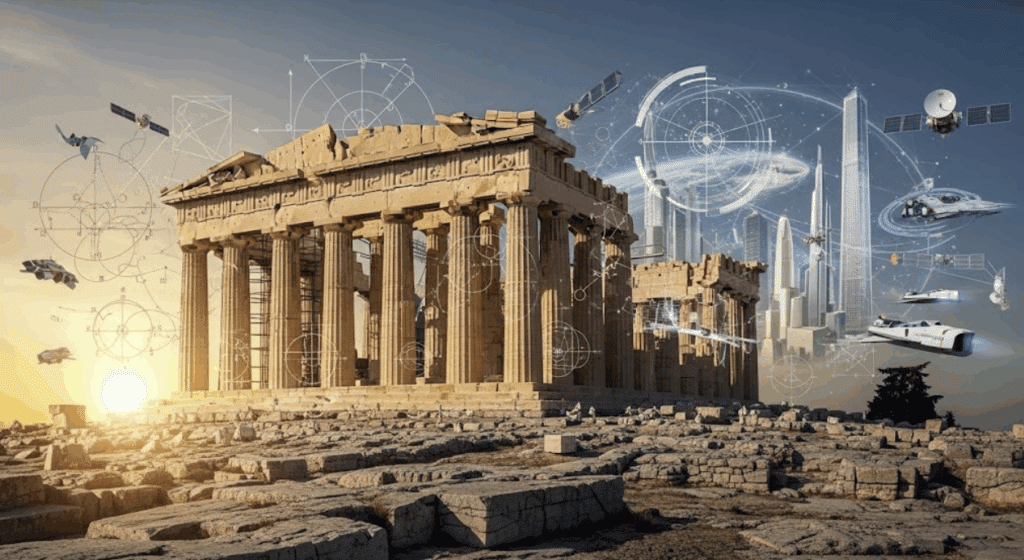

Geometry was never meant to be simple calculations that bore children; it was the Greeks’ adventurous attempt to decode the universe itself, and, honestly, they pretty much nailed it.
Standing in the shadow of the Parthenon today in modern-day Athens, you are witnessing mathematics and geometry at their finest, manifested in Pentelic marble. The Acropolis demonstrates how a handful of brilliant minds in ancient Greece determined the rules that still govern every bridge, building, and rocket we create to this day.

Around 300 BC, a mathematician in the bustling intellectual epicenter of Alexandria named Euclid made what might be the most influential decision in human history. He looked at centuries of scattered geometric knowledge—bits and pieces collected from Egypt, Babylon, and earlier Greek thinkers—and thought, “This mess needs organizing.” His solution became the “Elements,” thirteen books that collected geometric facts and proved them, step by logical step, promoting scientific methods at a time of widespread ignorance.
Euclid became renowned for not being satisfied with the approach of “this works because we’ve always done it this way.” While the Egyptians knew that a 3-4-5 triangle gave a perfect right angle, Euclid sought to understand why. A 3-4-5 triangle is a specific type of right-angled triangle, where the lengths of the sides are in the ratio 3:4:5. He needed to ascertain the rationale behind certain things being the way they were. This emphasis on proof over practice became the core of Western thought and remains the foundation of modern science. Every time a structural engineer calculates whether a beam can support its load, they are using Euclid’s focus on mathematical certainty.
The “Elements” became the second most published book in Western civilization after the Bible, at least until the 19th century. Students studied it for over two thousand years. Abraham Lincoln even taught himself geometry from Euclid’s work by candlelight. This is a type of influence that very few historical figures can claim they had.

If Euclid was the methodical organizer, Archimedes of Syracuse was a pure genius. He discovered the principle of buoyancy while taking a bath, then reportedly ran naked through the streets shouting “Eureka!” because he was too excited to get dressed first. That is the kind of passionate curiosity that changes the world—scientific innovation at its purest!
When Roman legions besieged Syracuse around 214 BC, Archimedes transformed his geometric insights into weapons that terrorized the Roman fleet. His catapults employed precise mathematical calculations to launch stones with devastating accuracy, causing significant damage to the advancing Romans. His compound pulleys could lift entire ships out of the water, leading Roman soldiers to reportedly flee at the sight of any rope or beam appearing over Syracuse’s walls, uncertain of what Archimedes’ contraption might emerge.
As for the famous “death ray,” that used mirrors to burn Roman ships… Well, modern physics suggests it’s improbable. However, the Romans certainly believed it was possible. In warfare, sometimes reputation matters more than reality, instilling widespread fear among soldiers who were not well-versed in physics.
Walk into any engineering firm today, and you will find the fingerprints of these curious ancient Greek innovators everywhere. Those Gothic cathedrals that still inspire awe after eight centuries? Medieval builders were applying Euclidean principles even when they couldn’t explain the mathematics behind their intuitions. They understood through experience what the Greeks had proven through logic—that certain geometric relationships create stability and beauty, making some things not only work but be spectacular at the same time.
This connection between these ancient Greeks and our modern world runs deeper than most people realise. Is your GPS calculating the fastest route home? That is pure coordinate geometry, refined (obviously) but fundamentally unchanged from Greek mathematical principles. The smartphone processing those calculations operates on geometric algorithms Archimedes would recognize, even if the silicon and code would baffle him and make him think that’s sorcery.

Consider the International Space Station orbiting above our heads. Its trajectory follows elliptical paths first described by Greek mathematicians. So, when SpaceX lands a rocket booster on a drone ship, they are using geometric calculations to predict exactly where a falling object will meet a moving target. This is quite literally pure applied Euclidean math at 21st-century standards.
The Greeks gave us something more valuable than individual theorems or formulas—they gave us a way of thinking outside of the box, which opens new doors instead of simply accepting the ones we already knew existed. They proved that abstract mathematical relationships could explain and predict physical reality. Before the Greeks, mathematics was mostly practical: measuring fields, calculating taxes, or building walls. The Greeks made it theoretical, and in doing so, they made it powerful.
This shift from “how” to “why” created the intellectual foundation for modern science and engineering. When a civil engineer designs a suspension bridge, they are applying principles of geometric analysis that trace directly back to ancient Greece. The engineer may never consciously think about Euclid, but every calculation rests on his logical framework and the legacy he left behind for us all to use.
Every skyscraper piercing a city skyline represents thousands of geometric calculations ensuring the building won’t collapse under its weight. Every airplane wing curved for optimal lift follows principles of geometric optimization that these pesky Greeks would immediately understand, even if they couldn’t imagine humans flying.
The remarkable thing isn’t that Greek geometry survived the fall of classical civilization—it is the fact that it became more essential as human civilization grew more complex. As we push further into space, dig deeper into quantum mechanics, and build increasingly sophisticated technologies, we rely more heavily, not less, on the logical framework those ancient mathematicians created. They gave us the tools to understand the universe, and we’re still using them to unlock its secrets.
